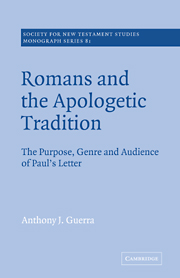Book contents
- Frontmatter
- Contents
- Preface
- List of abbreviations
- 1 Apologetic and audience: making the message meet
- 2 Apologetic motifs in Romans 1.18–3.31
- 3 Romans 4: the continuation of apologetic argumentation
- 4 Paul recommends and defends the gospel of God
- 5 Romans 9–11: Paul defends his mission to the Gentiles for the sake of the Jews
- 6 Romans 12–13 and 16: the “Roman factor”
- 7 Summary and conclusion
- Appendix
- Glossary
- Select bibliography
- General index
- Index of modern authors
3 - Romans 4: the continuation of apologetic argumentation
Published online by Cambridge University Press: 17 August 2009
- Frontmatter
- Contents
- Preface
- List of abbreviations
- 1 Apologetic and audience: making the message meet
- 2 Apologetic motifs in Romans 1.18–3.31
- 3 Romans 4: the continuation of apologetic argumentation
- 4 Paul recommends and defends the gospel of God
- 5 Romans 9–11: Paul defends his mission to the Gentiles for the sake of the Jews
- 6 Romans 12–13 and 16: the “Roman factor”
- 7 Summary and conclusion
- Appendix
- Glossary
- Select bibliography
- General index
- Index of modern authors
Summary
The thesis of the present chapter is that Paul continues his apologetic argumentation in Romans 4 by bringing forth Abraham both as a great testimonial figure and as scriptural confirmation. Paul's apologetic line of argumentation has its climax at Romans 3.29–30 with the affirmation of the One God. Romans 4 provides scriptural confirmation for his concern to manifest the continuity of the gospel of God with that which “God promised before” (cf. Rom. 1.1–2). The apologetic motifs here identified, it should be noted, are most appropriate to the protreptic genre. Before presenting my analysis of the apologetic motifs and logic of Romans 4, I will examine three recent interpretations of this chapter.
Three representative approaches to Romans 4
Earle Ellis: Romans 4 as midrash
Earle Ellis has focused attention on the hermeneutical principles informing Paul's use of the Old Testament. Paul often combines two or more quoted texts in various forms: a chain of passages (e.g. Rom. 15.9–12); a commentary pattern (Rom. 9–11 passim), both of which were commonly employed in Judaism; and composite or merged citations (Rom. 3.10–18). He also makes ad hoc renderings or interpretive selections from various known texts (cf. Rom. 9.33 and 10.11). Ellis argues that Paul, and the New Testament in general, interprets the Old Testament in a midrashic mode: “Explicit midrash appears in double entendre, in interpretive alterations of Old Testament citations and in more elaborate forms.”
- Type
- Chapter
- Information
- Romans and the Apologetic TraditionThe Purpose, Genre and Audience of Paul's Letter, pp. 102 - 125Publisher: Cambridge University PressPrint publication year: 1995



